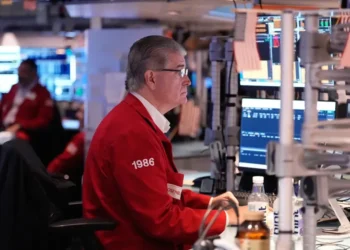U.S. Consumers Remain Resilient as Inflation Concerns Resurface
Published Time: 08-16-2025, 16:00
American consumers are once again expressing unease about inflation, but spending levels remain steady, helping sustain economic growth. While surveys show declining confidence tied to trade policy uncertainty and rising producer costs, robust employment and household resilience are keeping demand alive.
Inflation Concerns and Consumer Confidence
The University of Michigan reported on Friday that consumer sentiment fell 5% in August to 58.6, reversing four months of gradual improvement. The decline reflects renewed worries over tariffs introduced by President Donald Trump’s administration as part of its trade strategy.
Joanne Hsu, director of the University of Michigan’s survey, noted that “consumers continue to expect both inflation and unemployment to deteriorate in the future,” even though current conditions remain relatively stable.
Expectations for inflation in the year ahead rose to 4.9%, up from 4.5% in July, signaling that households are bracing for higher costs. However, recent history suggests that falling sentiment does not always translate into weaker consumer activity.
The Role of Employment in Sustaining Spending
The labor market remains one of the strongest supports for household spending. Unemployment is currently at 4.2%, according to the Labor Department. With steady job growth and historically low levels of unemployment claims, most Americans still have both the income and confidence to maintain consumption.
Chris Zaccarelli, chief investment officer at Northlight Asset Management, explained in a note that “as long as consumer spending holds up and companies are able to retain workers because of that robust spending, the flywheel can continue to spin, pushing corporate profits and stock prices higher.”
How Businesses Are Managing Tariff Pressures
Since early 2025, tariffs have been a central feature of U.S. trade policy. Economists initially warned that higher import costs could fuel rapid consumer inflation. Yet so far, businesses have adopted strategies to shield consumers from the full impact.
A report from the Federal Reserve Bank of Richmond highlighted measures such as delaying orders, staggering the timing of tariff charges, negotiating cost-sharing with suppliers, and stockpiling inventory ahead of new tariff rounds.
These approaches have allowed companies to contain inflationary pressures, at least temporarily. “Sensing from businesses suggests that the impact of tariffs on their price-setting has been lagged, but it is starting to play out,” Richmond Fed economists wrote.
Still, warning signs are emerging. The Producer Price Index, which measures the costs businesses pay for goods and services, rose 0.9% in July, pushing the annual rate to 3.3%. The figures exceeded economists’ expectations and could signal higher consumer prices in the months ahead.
Consumer Sentiment vs. Spending Behavior
Historically, consumer sentiment has not been a reliable predictor of actual spending. For example, in 2022, sentiment fell to record lows during a 40-year high in inflation, yet consumer spending remained strong. Similarly, in 2023, despite uncertainty surrounding the congressional debt ceiling standoff, households continued to shop at consistent levels.
This disconnect appears to be persisting in 2025. Although confidence has slipped, retail sales data shows that consumers are still actively spending across a variety of categories.
Retail Sales Hold Steady
The Commerce Department reported that retail sales rose 0.5% in July, aligning with economists’ forecasts. Although the pace slowed from June’s upwardly revised 0.9% gain, the figures point to steady consumer demand.
Sales rose notably at car dealerships (up 1.6%) and furniture stores (up 1.4%). Online shopping also grew by 0.8%, boosted by Amazon’s annual Prime Day promotions. Gas stations and department stores reported gains as well, reflecting broader consumer activity.
However, some categories lagged. Home improvement stores saw sales fall 1%, while electronics retailers posted a 0.6% decline. Restaurants and bars also slipped 0.4%, extending a period of subdued performance in the dining sector.
A “control group” measure of retail sales, which excludes volatile categories, rose 0.5% in July, slightly beating economists’ expectations. Even after adjusting for the Consumer Price Index’s 0.2% monthly increase, real spending remained positive at 0.3%.
Bill Adams, chief economist at Comerica Bank, emphasized this resilience, writing, “What consumers do is more important to the economy than what they say.”
Outlook for the U.S. Economy
The U.S. economy continues to depend heavily on consumer spending, which accounts for roughly 70% of total output. While businesses and households have so far absorbed the pressures of tariffs and higher production costs, economists caution that this resilience may not last indefinitely.
If producer costs continue to rise and companies begin passing them onto consumers, inflation could accelerate, putting more pressure on household budgets. At the same time, uncertainty surrounding trade policy could weigh on confidence and business investment.
For now, the combination of strong employment, business adaptability, and steady consumer demand has allowed the U.S. economy to maintain momentum despite policy headwinds. But analysts warn that if inflation expectations continue to climb, spending habits could shift in the months ahead.
This article was rewritten by JournosNews.com based on verified reporting from trusted sources. The content has been independently reviewed, fact-checked, and edited for accuracy, neutrality, tone, and global readability in accordance with Google News and AdSense standards.
All opinions, quotes, or statements from contributors, experts, or sourced organizations do not necessarily reflect the views of JournosNews.com. JournosNews.com maintains full editorial independence from any external funders, sponsors, or organizations.
Stay informed with JournosNews.com — your trusted source for verified global reporting and in-depth analysis. Follow us on Google News, BlueSky, and X for real-time updates.













